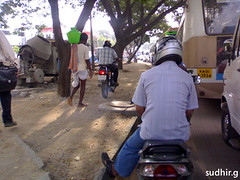


| originally posted at the cityfix_ |
|
| Krishnappa is a security guard
for a multinational software firm in
Bangalore who, for the past thirty years, has walked and cycled to
work. For Krishnappa, the trip, which often took around 15 to 30
minutes, was one of life’s small pleasures as he made his way along
Bangalore’s tree-shaded streets, often meeting friends and
acquaintances, discussing politics and family matters, before
continuing on his way. However, in recent years he has been unable to
walk or cycle to work. And it’s not because of age or injury. |
 All pictures by Sudhir G.
|
| When
asked about his transport woes, he blames the government. The
increase in land prices, lack of cycle tracks, footpaths, poor public
transportation, and the risk of being struck by a motorized vehicle
have forced him to drive to work. He now spends nearly 30% of his
salary on his monthly commute. Krishnappa is not alone. Rapidly growing Bangalore city has generated a new human species aptly named “Transport Challenged People.” The common trait of these people is that they are forced to become captive to a mode of transport just because they don’t have an accessible alternative. Their other characteristic is that they pay a price for traveling that they do not consider fair or just, but because they have no other option, they continue to pay it. Bangalore has seen a spiral of economic activity and urban growth, with the developed area of the city increasing from roughly 175 square kilometers in 1971 to more than 560 in 2006. The government, in order to decongest the city center, restricted the Floor- Space-Index (FSI) – that’s a technical term for building density - in the core and liberated the FSI along the outer peripheries. The restriction in FSI in the city core caused land value here to skyrocket, driving out the lower class to the more affordable peripheries. (There’s a photo essay after the jump) Check out the complete article at http://thecityfix.com/behind-bangalores-growth-a-new-species-is-born-transport-challenged-people/ For a more thorough discussion, please click here. Other aritcles in response Are Mumbai's planners looking at Bangalore? Transport Challenged In Bangalore Related Articles: Bicycles on the Verge of Extinction in Bangalore Congestion to Demotorisation - A Paradigm Shift for Bangalore (in Portland Car Free Day) Congestion to Demotorisation - A Paradigm Shift for Bangalore (in Clean Air Initiative)
Praja.in comment guidelinesPosting Guidelines apply for comments as well. No foul language, hate mongering or personal attacks. If criticizing third person or an authority, you must be fact based, as constructive as possible, and use gentle words. Avoid going off-topic no matter how nice your comment is. Moderators reserve the right to either edit or simply delete comments that don't meet these guidelines. If you are nice enough to realize you violated the guidelines, please save Moderators some time by editing and fixing yourself. Thanks! |



ಪ್ರತಿಕ್ರಿಯೆಗಳು
That is why before i
That is why before i emphasised the need for "Multi Modal Transport" in order to cater to the different needs of different people. Middle class people like Krishnappa in the story above could take the commuter rail (if implemented), say from middle class localities like the recently proposed Kempe Gowda Layout in Kengeri to Electronics City paying about Rs. 500 per month.
At that cost - it would work out for the railways to provide a daily train service within important points in the city network.
Those who work above the value chain, could take the Metro which costs a bit more and thereby eliminate the need and presence of cars, cabs, vans, two-wheelers et al, during peak hours.
TCP-OB protocol for human transport